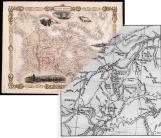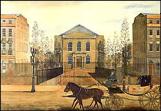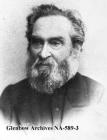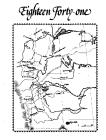1
The history of Rundle's Mission is connected to the people and places of the region, before and during the settlement era, beginning in 1840 and continuing to the beginning of the 20th century.3
Robert Terrill Rundle was chaplain to the Hudson's Bay Company at Fort Edmonton and a missionary among the First Nations people of the region, from 1840 to 1848.5
The following vignettes are based on conversations with Gerald Hutchinson. In 1992, Rev. Hutchinson related the story of Rundle's Mission and his own experience as a United Church of Canda minister to a gathering of colleagues and lay people.7
Gerald Hutchinson:... He founded only one mission. And that was located just here on the shores of Pigeon Lake. He was part of a much larger scheme in which the British Wesleyan Mission Society and the Hudson's Bay Company-- with their head offices in London, England-- agreed on an unusual partnership of Company and Church: to send a team of four men to the Hudson's Bay territories. The Reverend James Evans was a superintendent living at Norway House, north of Lake Winnipeg. George Barnley was at Moose Factory at the south end of Hudson's Bay. William Mason was further south of Manitoba at Rainy Lake. And Robert Rundle was based at Fort Edmontonůso he had this whole western region to roam in.
9
At the time, the Hudson's Bay Company faced criticism in Britain, over allegations of its treatment of native people and their impoverishment. Seeking to address this situation, the Company offered to sponsor Methodist missionaries. The Methodist Church in England worked among the urban poor and its ability to work in difficult situations made it a likely alliance for the Company.As one of these four Methodist missionaries, Robert Rundle came to a land marked by the fur trade economy. To the north of the North Saskatchewan River, the Company influenced the Cree peoples to expand their territory to the west and south.
11
Gerald Hutchinson:...From the Saskatchewan River south was completely First Nations country, occupied and controlled by the Stoney [Nakoda], the Cree, the Bloods [Kainai] and the Blackfoot. The operation of Hudson's Bay in the region gave new impetus to the Cree. Trading gave them new tools and money to work with and they became hunters, gatherers and fur traders. Because of this, the Cree took the initiative and moved west, then through the north country and onto the plains as well.
13
Gerald Hutchinson:...They could follow the river around to Fort Edmonton and to Rocky Mountain House but the rest of it was off limits. So when the Plains or Northern tribes wanted to meet the Hudson's Bay traders, they met at Rocky Mountain House. That was the gathering point. And Rundle's Mission was established on the margin between Hudson's Bay territory and First Nations territory, accessible from both sides.






